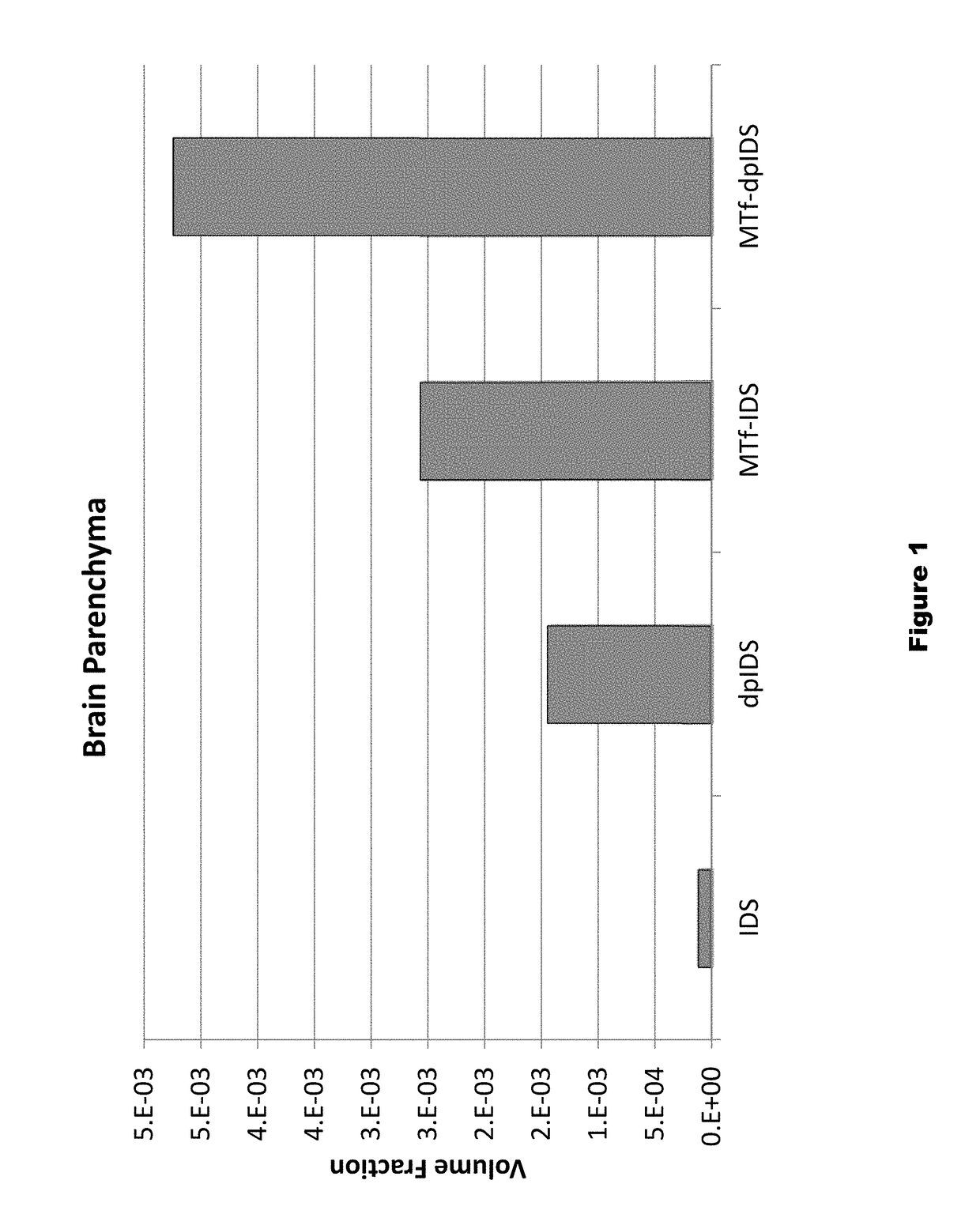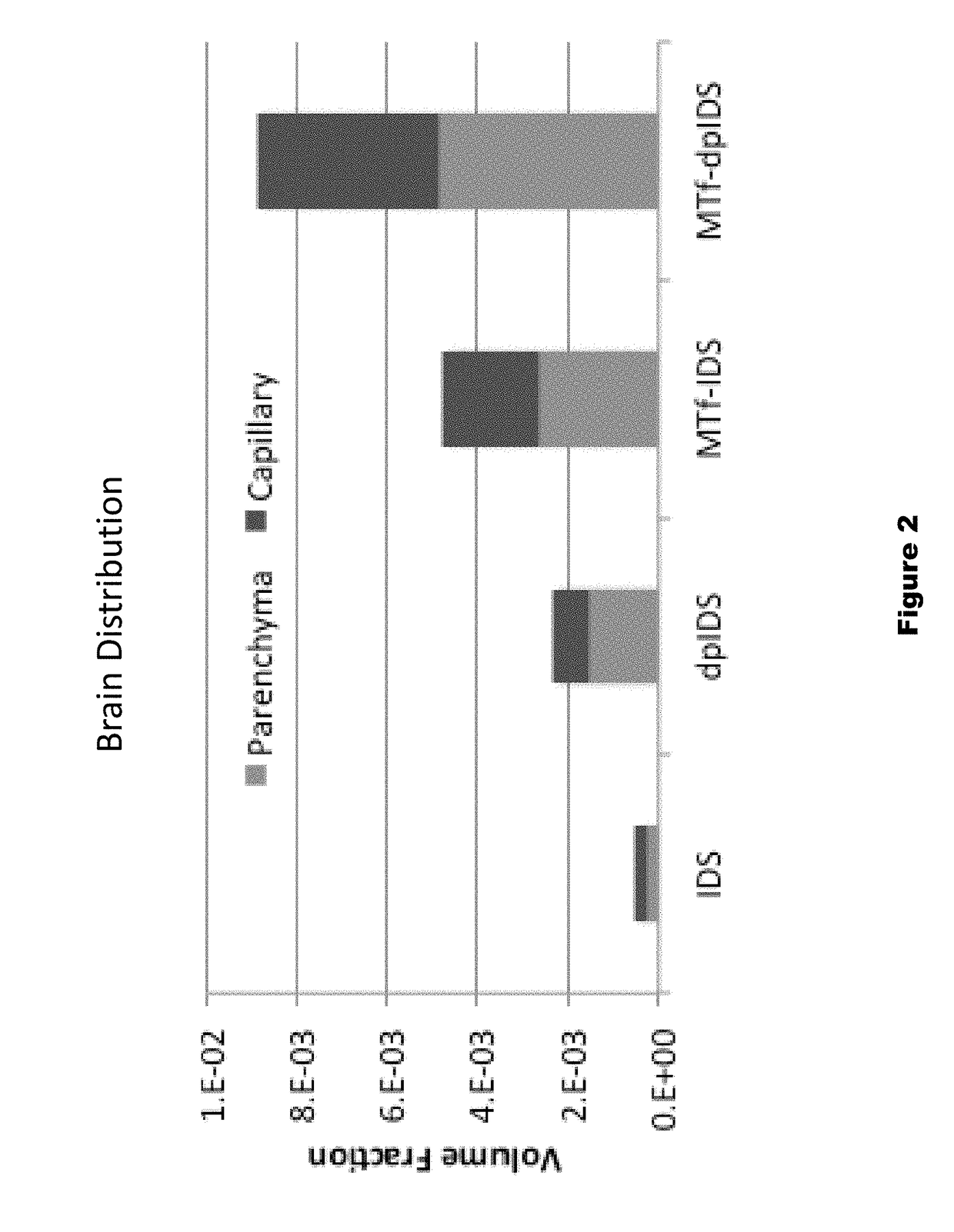Dephosphorylated lysosomal storage disease proteins and methods of use thereof
a technology of lysosomal storage disease and lysosomal storage disease, which is applied in the direction of metabolism disorder, drug composition, peptide/protein ingredient, etc., can solve the problems of cell and tissue damag
- Summary
- Abstract
- Description
- Claims
- Application Information
AI Technical Summary
Benefits of technology
Problems solved by technology
Method used
Image
Examples
example 1
Preparation of Dephosphorylated Iduronidase (DpIDU)
[0264]Iduronidase was treated with Affigel-immobilized potato acid phosphatase (PAP) to remove phosphate groups.
[0265]Preparation of Affigel-Immobilized PAP.
[0266]Following the protocol provided by BioRad for immobilization of proteins to Affigel, 20 ml of fresh Affigel suspension was placed in a 50 ml polypropylene screw-top tube and washed five times with MilliQ H2O. Three milliliters of H2O and 0.83 ml of 3M NaOAc pH 5.2 was added to a final volume of approximately 25 ml. 360 mg of PAP was solubilized in 10 ml of 0.1 M NaOAc, and 0.5 ml was retained to check the starting OD 280. The PAP solution was added to Affigel solution, mixed, and placed on rocker at 4° C. for overnight incubation.
[0267]The following morning, the gel was settled gently (e.g., 400 rpm in benchtop centrifuge for 1-2 sec., or let stand to settle gel). The supernatant was removed and retained to check the final OD 280 (to check linkage efficiency). Unlinked sit...
example 2
Preparation of p97-Dephosphorylated Iduronate-2-Sulfatase (DpIDs) Conjugates
[0273]To prepare labeled test proteins and conjugates, dpIDS was prepared from recombinant IDS by treatment with acrylic bead-bound calf intestine alkaline phosphatase (CIP) to reduce the number of phosphate groups.
[0274]Recombinant IDS (4.5 ml @ 1.5 mg / ml; produced in human HT-1080 cells) was treated with pre-equilibrated CIP-Acrylic beads overnight at 37° C. with gentle mixing. CIP beads were transferred to a column, flow through (FT) was collected, and beads were washed with approximately 25 ml of PBS. All FT and wash fractions were collected and concentrated to 4.5 ml. CIP beads were then re-equilibrated with 10 mM Tris, 50 mM NaCl, 5 mM MgCl2 pH 8.0 and reused for other sub-batches of IDS. 29 mg CIP-treated dpIDS (dephosphorylated IDS) was produced in the first batch used for conjugation. No reduction of specific activity was observed for dpIDS (see Table 1). However, reduction of binding to soluble man...
example 3
Distribution of Dephosphorylated Iduronate-2-Sulfatase (DpIDS) and P97-DpIDU Conjugates in Brain Tissue
[0291]Experiments were performed to evaluate distribution of AF647-labeled IDS, dpIDS, p97 (MTf)-IDS conjugates, and p97 (MTf)-dpIDS conjugates in brain tissue compartments. AlexaFluor 647 (AF647)-labeled proteins were injected intravenously into mice according to the following Table.
[0292]
TABLE 4Injected dose for dpIDS study.InjectedApprox. MWInjected DoseDoseAgentMice(g / mole)(mg / kg)(moles / kg)IDS-AF647376,00067.9e−8dpIDS-AF647376,00067.9e−8MTf-IDS-AF6473158,00012.57.9e−8MTf-dpIDS-AF6473158,00012.57.9e−8
[0293]About two hours post-injection of labelled test proteins, intracardiac brain perfusion was performed to wash out blood from the cerebral vasculature without damaging the blood brain barrier. This procedure was performed prior to brain dissection and preparation of brain tissue for histological and biodistribution studies. Here, tomato lectin (100 μg) was first injected (tail v...
PUM
| Property | Measurement | Unit |
|---|---|---|
| pH | aaaaa | aaaaa |
| pH | aaaaa | aaaaa |
| pH | aaaaa | aaaaa |
Abstract
Description
Claims
Application Information
 Login to View More
Login to View More - Generate Ideas
- Intellectual Property
- Life Sciences
- Materials
- Tech Scout
- Unparalleled Data Quality
- Higher Quality Content
- 60% Fewer Hallucinations
Browse by: Latest US Patents, China's latest patents, Technical Efficacy Thesaurus, Application Domain, Technology Topic, Popular Technical Reports.
© 2025 PatSnap. All rights reserved.Legal|Privacy policy|Modern Slavery Act Transparency Statement|Sitemap|About US| Contact US: help@patsnap.com



